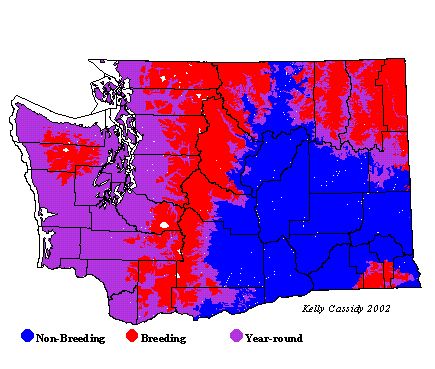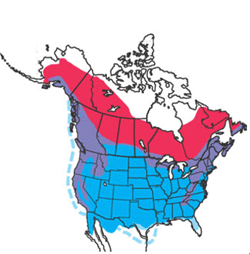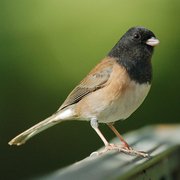Dark-eyed Junco
General Description
The Dark-eyed Junco is commonly found in Washington in two forms, the Oregon and the Slate-colored. It is unclear whether other races of Dark-eyed Junco occur in the state. In Washington, the Oregon form is by far the more common. All forms in Washington have distinctive white outer tail feathers, white bellies, and pink bills. Oregon Juncos have dark hoods, which are bold black in males and gray in females and juveniles. They have rufous sides, brown backs, and gray wings. Slate-colored Juncos may have a brownish tinge on their backs, but for the most part are dark gray all over except for the white belly.
Habitat
During the breeding season, Dark-eyed Juncos use a variety of forested habitat, but prefer moist conifer or mixed forests with dense understory and forest openings. During the winter, they can be found in open woodlands and brushy areas including towns, gardens, and shrub-steppe habitat.
Behavior
Dark-eyed Juncos are flocking birds with a distinct social hierarchy. They forage on the ground in these groups, scratching with their feet to find food. The flash of white tail feathers serve as a signal that alerts members of the flock when one is alarmed.
Diet
During the summer, about half of the Dark-eyed Junco's diet is made up of insects and other arthropods, the other half consists of seeds. The young eat mostly arthropods. In winter, the diet shifts more to seeds and berries.
Nesting
The male Dark-eyed Junco sings from a high perch to defend his territory and attract a mate. During courtship, both members of a pair hop about on the ground with their wings drooped and their tails spread, showing off their white outer tail feathers. The nest, which the female builds, is almost always on the ground. It is often in a depression, hidden under grass, a log, a rock, or an upturned tree root. The nest is a cup made of grass, moss, lichen, rootlets, twigs, and bark fiber, and is lined with fine grass, hair, or feathers. The female incubates 3 to 5 eggs for 11 to 13 days. Both parents feed the chicks, which leave the nest at 9 to 11 days. Pairs typically raise 1 or 2 broods per year.
Migration Status
Most Dark-eyed Juncos are migratory, following the food supply south, but many will winter over, given an adequate food supply. Males winter farther north than females. Some Washington birds are resident, but most migrate either north-south, or up and down in elevation.
Conservation Status
Until 1973, the five different forms of the Dark-eyed Junco were considered five separate species. Dark-eyed Juncos are widespread and abundant in Washington.
When and Where to Find in Washington
Dark-eyed Juncos are among the most abundant winter birds in Washington, present in almost all habitats with the exception of high altitudes and dense forests. They are most common in winter in the western lowlands, but many can also be found in eastern Washington, where they are patchily distributed but often form flocks of up to 100 birds. As breeders, they are common and widespread in appropriate habitat in forested zones, even in city parks.
 Abundance
Abundance
| Ecoregion | Jan | Feb | Mar | Apr | May | Jun | Jul | Aug | Sep | Oct | Nov | Dec |
|---|---|---|---|---|---|---|---|---|---|---|---|---|
| Oceanic | ||||||||||||
| Pacific Northwest Coast | C | C | C | C | C | C | C | C | C | C | C | C |
| Puget Trough | C | C | C | C | C | C | C | C | C | C | C | C |
| North Cascades | C | C | C | C | C | C | C | C | C | C | C | C |
| West Cascades | C | C | C | C | C | C | C | C | C | C | C | C |
| East Cascades | C | C | C | C | C | C | C | C | C | C | C | C |
| Okanogan | C | C | C | C | C | C | C | C | C | C | C | C |
| Canadian Rockies | C | C | C | C | C | C | C | C | C | C | C | C |
| Blue Mountains | F | F | F | F | F | C | C | C | C | C | C | C |
| Columbia Plateau | C | C | C | C | F | C | C | C | C |
Washington Range Map

North American Range Map


Family Members
 Green-tailed TowheePipilo chlorurus
Green-tailed TowheePipilo chlorurus Spotted TowheePipilo maculatus
Spotted TowheePipilo maculatus American Tree SparrowSpizella arborea
American Tree SparrowSpizella arborea Chipping SparrowSpizella passerina
Chipping SparrowSpizella passerina Clay-colored SparrowSpizella pallida
Clay-colored SparrowSpizella pallida Brewer's SparrowSpizella breweri
Brewer's SparrowSpizella breweri Vesper SparrowPooecetes gramineus
Vesper SparrowPooecetes gramineus Lark SparrowChondestes grammacus
Lark SparrowChondestes grammacus Black-throated SparrowAmphispiza bilineata
Black-throated SparrowAmphispiza bilineata Sage SparrowAmphispiza belli
Sage SparrowAmphispiza belli Lark BuntingCalamospiza melanocorys
Lark BuntingCalamospiza melanocorys Savannah SparrowPasserculus sandwichensis
Savannah SparrowPasserculus sandwichensis Grasshopper SparrowAmmodramus savannarum
Grasshopper SparrowAmmodramus savannarum Le Conte's SparrowAmmodramus leconteii
Le Conte's SparrowAmmodramus leconteii Nelson's Sharp-tailed SparrowAmmodramus nelsoni
Nelson's Sharp-tailed SparrowAmmodramus nelsoni Fox SparrowPasserella iliaca
Fox SparrowPasserella iliaca Song SparrowMelospiza melodia
Song SparrowMelospiza melodia Lincoln's SparrowMelospiza lincolnii
Lincoln's SparrowMelospiza lincolnii Swamp SparrowMelospiza georgiana
Swamp SparrowMelospiza georgiana White-throated SparrowZonotrichia albicollis
White-throated SparrowZonotrichia albicollis Harris's SparrowZonotrichia querula
Harris's SparrowZonotrichia querula White-crowned SparrowZonotrichia leucophrys
White-crowned SparrowZonotrichia leucophrys Golden-crowned SparrowZonotrichia atricapilla
Golden-crowned SparrowZonotrichia atricapilla Dark-eyed JuncoJunco hyemalis
Dark-eyed JuncoJunco hyemalis Lapland LongspurCalcarius lapponicus
Lapland LongspurCalcarius lapponicus Chestnut-collared LongspurCalcarius ornatus
Chestnut-collared LongspurCalcarius ornatus Rustic BuntingEmberiza rustica
Rustic BuntingEmberiza rustica Snow BuntingPlectrophenax nivalis
Snow BuntingPlectrophenax nivalis McKay's BuntingPlectrophenax hyperboreus
McKay's BuntingPlectrophenax hyperboreus

